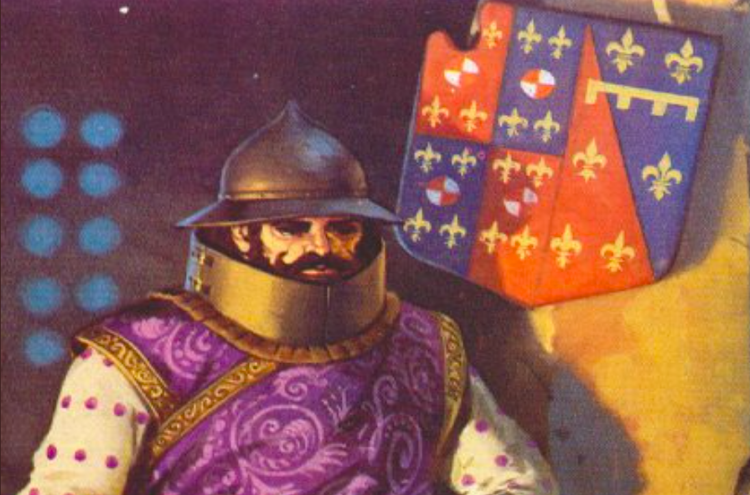
Strazimir I Balsha: Expander of the Balsha Principality
Strazimir I Balsha (r. 1362-1372) was the son and immediate successor of Balsha I (the attested founder of the Albanian Balsha principality). He ruled over the Balsha principality for one expansionist decade. His two other brothers, Gjergj I (George I Balsha) and Balsha II Balsha assisted him in governance, forming a medieval tetrarchy. In his early years, the territories ruled by Strazimir Balsha consisted of the upper Zeta (upper Montenegro) and the region of NënShkodër (Lower Shkodra – northeast of Albania).
A Rapid Expansion
Strazimir initiated a period of rapid expansion that would culminate in the 1380s. To make this expansion possible, crushing Serbian authority, military occupation, and influence was vital. According to Eqrem bej Vlora, Strazimir and his brothers did just that and: decided to rupture Serbian sway in northern Albania, once and for all. In 1363, as Marin Barleti described briefly, Balshas “attacked Shkodra, under the possession of [Stefan] Uroš [V]…and seized it”. Between 1363-1367, if not earlier, the Balshas established a firm grip over the coastal towns of Ulqini (Ulcinj) and Tivari (Bar). In 1367, Strazimir concluded the complete conquest of Budua (Budva), completing his policy of coastal domination across southern Zeta.

The complete domination of the coast from Budva to Lezha promised substantial commercial profits from the Adriatic trade. They further grew their revenues by effectively leveraging their control over the customs along the Buna (such as Shirgj) and along the land route linking Lezha with Kosova. In 1368, after taking their attacks as far north as Kotorr, the weak Serbian ruler Stefan Uroš V (r. 1355-1371) proclaimed the Balshas as “rebels and irreconcilable adversaries of the Serbian court“.
Marital alliance
The feud with the Serbian court did not prevent marital links between the Balshas and the Serbs. They used such diplomatic institutions smartly, establishing ties with contenders of the Serbian court, further fueling the de-centralization of the Serbian state. Strazimir married Milica Mrnjavčevic, daughter of Serbian ruler Vukašin of Serbia (co-ruler with Uroš V from 1365 to 1371). In addition to pacification marriages, Strazimir maintained friendly ties with both the enclave of Ragusa (Dubrovnik) and the Venetian Republic. All brothers, including Strazimir, had been awarded Ragusan honorary citizenship in 1361 and Venetian citizenship in 1362.

The Love-Hate Relation With the Thopia
The expansion south caused conflict with other Albanian noble families such as the Dukagjini and Thopia. As the Balsha brothers tried to cross their forces south of the Mati river, they encountered the resistance of Karl Thopia. In September 1364, the Balshas fought a battle with the Thopias, which the latter ultimately won. Gjergj I Balsha was taken captive. However, with the intervention of Ragusa, he was later released.

In the post-war negotiations, the parties established a peace treaty. They sealed this treaty with a marriage between Katerina (Catherine) Balsha, the only attested sister of the Balsha brothers, with Karl Thopia. The terms remain obscure, but the following events suggest the establishment of military cooperation and the free passage of all parties in respective territories. The clause on free movement proved especially crucial for the Balshas’ later expansion in southern Albania.
As for the Dukagjini, Strazimir and his brothers annexed from them all territories across northern Albania, probably using force. The reverse probably happened with them; the Balshas defeated them in battle and later used a marital truce for post-war gains. Strazimir took as a wife the daughter of Progon Dugagjini, Irenë Duklina.
Shifting Religious Attachment
Beginning in 1368, the Balsha family took their anti-Serbian and pro-Western policy to another level when they collectively renounced their Orthodox faith and embraced Roman Catholicism before bishop Pjetër of Shas on 29 January 1369. Pope Urban V hailed this commitment on 25 May 1368 (“Nobilis virus Strazimiro et Georgio de Balse fatribus Zapanis Zente gratiam in praesenti per quam gloriam in futuro…”). Only one year after this local but large ceremony, the pope recommended to the Balsha brothers the new bishops of Arbëria (Arbënia), Pult, Sarda (Shurdhah), Lezhë, and Vlorë.

Strazimir seems to have genuinely embraced the new Catholic denomination. In about 1372, he “abdicated” from governance and spent the final months of his life (until 15 January 1373) as a monk. He left three attested sons, all through his wife Milica: Gjergj II (r. 1385-1403), Gojko, and Ivanishi.
Bibliography
Akademia e Shkencave e Shqipërisë. Instituti i Historisë. Historia e Popullit Shqiptar, I, p. 137. Botimet Toena, 2002.
Elsie, R. (2013). A biographical Dictionary of Albanian History. p. 27. Published by I.B. Tauris & Co. Ltd. ISBN: 978 1 78076 431 3.
Directorium ad passagium faciendum (Initiative for Making the Passage). Anonymous, (1332). Retrieved from: http://www.albanianhistory.net/1332_Making-the-Passage/index.html.
Métais, S. (2006). Histori E Shqiptarëve: Nga Ilirët Deri Te Pavarësia E Kosovës. Botimet 55, Tiranë.
Muzaka, Gj. (1515). Brief Chronicle on the Descendants of our Musachi Dynasty*. Retrieved from: http://www.albanianhistory.net/1515_Musachi/index.html. *Title displayed here not as in the original manuscript.
Plasari, A. (2018). Skënderbeu – Një Histori Politike. Botimet IDK, Tiranë.
Varfi, Gj. (2000). Heraldika Shqiptare. Dituria – Tiranë.
Vlora, E. B. (1956). Beiträge zur Geschichte der Türkenherrschaft in Albanien: eine historische Skizze (translated in English as: The Ruling Families of Albania in the pre-Ottoman period). Translated by Robert Elsie. Retrieved from: http://www.albanianhistory.net/1956_Vlora/index.html. Excerpt from an unfinished, incomplete, or unpublished work.







